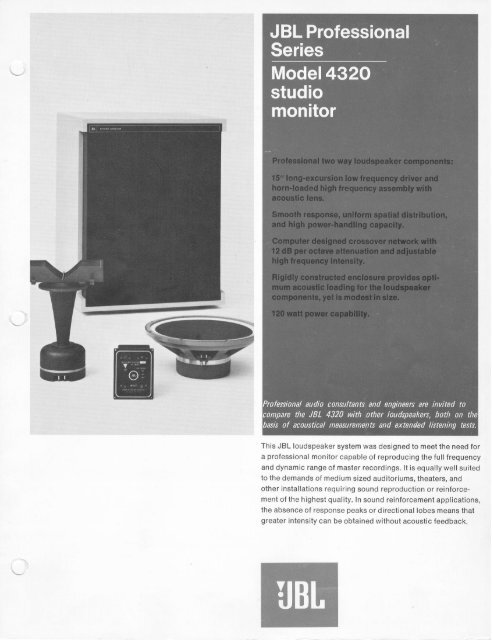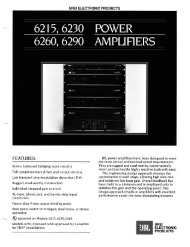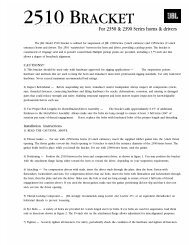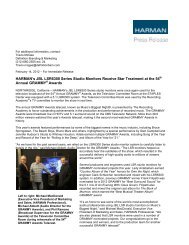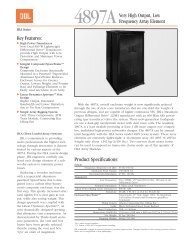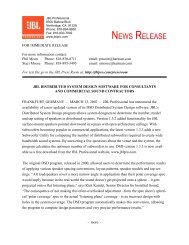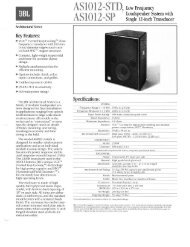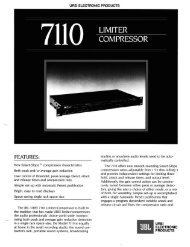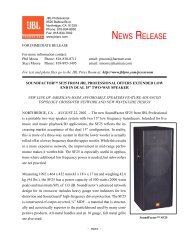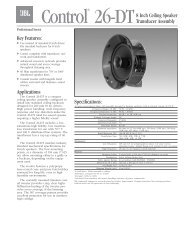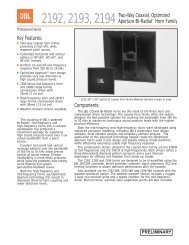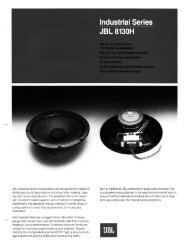Professional two way loudspeaker components ... - JBL Professional
Professional two way loudspeaker components ... - JBL Professional
Professional two way loudspeaker components ... - JBL Professional
Create successful ePaper yourself
Turn your PDF publications into a flip-book with our unique Google optimized e-Paper software.
<strong>Professional</strong> <strong>two</strong> <strong>way</strong> <strong>loudspeaker</strong> <strong>components</strong>:15” long-excursion low frequency driver andhorn-loaded high frequency assembly withacoustic lens.Smooth response, uniform spatial distribution,and high power-handling capacity.Computer designed crossover ne<strong>two</strong>rk with12 dS per octave attenuation and adjustablehigh frequency intensity.Rigidly constructed enclosure provides optimumacoustic loading for the <strong>loudspeaker</strong><strong>components</strong>, yet is modest in size.120 watt power capability.This <strong>JBL</strong> <strong>loudspeaker</strong> system was designed to meet the need fora professional monitor capable of reproducing the full frequencyand dynamic range of master recordings. It is equally well suitedto the demands of medium sized auditoriums, theaters, andother installations requiring sound reproduction or reinforcementof the highest quality. In sound reinforcement applications,the absence of response peaks or directional lobes means thatgreater intensity can be obtained without acoustic feedback.
<strong>JBL</strong> Model 4320 studio monitorEnclosureThe acoustical enclosure of the <strong>JBL</strong> 4320 system is made of?&inch plywood for maximum rigidity with minimum weight. Jointsare lock-mitered and wood-welded. Interior surfaces are heavilybraced and padded to prevent unwanted resonance. For maximumstructural integrity, there are no demountable panels;<strong>loudspeaker</strong> <strong>components</strong> mount directly from the front of thebaffle board. A pair of ducted ports give added acoustic loadingand increased efficiency in the 30-50 Hz frequency range.2215 Bass DriverLow frequencies are reproduced by this massive 15-inch <strong>loudspeaker</strong>having a 4-inch edgewound copper ribbon voice coiloperating in a magnetic field of 11,000 Gauss. Total magneticflux in the voice coil gap is 450,000 Maxwells. Because of thesophisticated magnetic circuit and voice coil configuration, thecoupling coefficient of the 2215 is extremely high: 10 watts ofDC into the voice coil produces approximately 5.5 pounds offorce acting on the cone. The cone itself is terminated in a ringof molded internally-damped foam developed by <strong>JBL</strong>. This exclusivetermination allows cone excursions greater than %-inchwhile at the same time acting as a non-reflective acoustic terminationfor sound waves travelling through the cone. Model 2215has a magnetic circuit weighing 19% pounds, a free-air coneresonance of 20 Hz, and a BI factor of 2.2 x 1O’dynesper abampere.3110 Frequency Dividing Ne<strong>two</strong>rkImperceptible transition between low and high frequency transducersis made by a dividing ne<strong>two</strong>rk whose circuit was determinedby computer design and refined through extendedacoustic tests with the <strong>components</strong> of the 4320 system. The ne<strong>two</strong>rkincludes special reactive <strong>components</strong> to compensate forthe complex impedance characteristics of the transducers andto maintain the desired 12 dB per octave slope in terms of actualacoustic output. A 3.position switch allows the intensity of thehigh frequency driver to be balanced to the liveness of the listeningenvironment. The attenuation circuit uses a tapped autotransformerrather than resistive pads so that coupling betweenamplifier and transducer is not adversely affected by the settingof the control.Loudspeaker <strong>components</strong> of Model 4320-,
2420 High Frequency DriverAbove a crossover frequency of 800 Hz, the 2420 high frequencydriver operates smoothly through a range greater than4 octaves. The diaphragm of the 2420 is hydropneumaticallydrawn to shape from 0.002~inch dural alloy and is driven by a1 J/4” edgewound aluminum ribbon voice coil operating in a fieldof 19,000 Gauss. A pure silver impedance-controlling ring counteractsthevoice coil inductive component, resulting in greatlyimproved efficiency through the highest octave of audible frequencies.Energy from the diaphragm is conducted to the hornthroat through concentric channels of a mathematically determinedphasing plug; sound waves are conducted to the hornthroat in constant phase relationship.2307 Horn-Lens AssemblyThe2420 is coupled to a heavy cast aluminum exponential hornwith slant-plate acoustic lens. The 2307 lens is designed accordingto advanced wave propagation theory and acts exactly as adivergent optical lens. The formula for hyperbolic cylindricallenses is used to determine the basic parameters of the 2307. Itemploys 11 plates set at an angle of 38”, spaced 0.25 inches centerto center. Because of the precisely calculated hyperbolic curvatureof the front of the lens, sound is spread evenly through a120” lateral angle, but restricted to approximately40” in thevertical direction.Test ParametersThe accompanying graphs and specifications were compiledfrom measurements made under standard laboratory test conditions.The loudspseakersystem was mounted flush in the centerof a large flat baffle in an anechoic environment. A calibratedcondenser microphone was suspended at a known distancefrom the sound source, sufficiently far to be safely out of thenear field. All associated electronic equipment was checked andcalibrated before tests were run.Polar response of 4320 in the horizontal plane. The above curveswere traced by an automatic recorder with the high frequency assemblylocated in a free-field environment. Power fed to the high frequencydriverwasadjustedtogivethesameDdB reference inall cases.Note that even without help from the adjacent reflecting surfaceswhich are present when the assembly is installed in a cabinet, thedistribution pattern is extremely smooth over a wide horizontal angle.There are no prominent lobes. and all three curves follow each otherclosely ewn tho”gh they cover a frequency range of almost 4 octaves.In free space a listener sitting 45” off axis would hear almost exactlythe same overall response as someone directly on axis. The re-flected sound present in any normal listening environmenteffectivelyswamps out even these minor differences, so that coverage is uni-form through a lateral angle of approximately 1204
ArchitecturalspecificationsThe <strong>loudspeaker</strong> system shall consist of a 15” low frequency<strong>loudspeaker</strong>, horn-loaded high frequency driver,and frequency dividing ne<strong>two</strong>rk installed in a tubeportedenclosure. Loudspeakers, ne<strong>two</strong>rk and enclosureare to be manufactured and assembled by a singlemanufacturer. Components shall be removable from thefront of the enclosure.The low frequency <strong>loudspeaker</strong> shall have a 4-inchedgewound copper ribbon voice coil operating in amagnetic field of at least 11,000 Gauss, with 450,000Maxwells total flux. The magnetic assembly shall weighat least 19 pounds.The frequency dividing ne<strong>two</strong>rk shall have a crossoverfrequency of 800 Hz and shall be of the parallel L-Ctype, with additional <strong>components</strong> to compensate for thecomplex impedance characteristics of the transducers.High frequency attenuation shall be accomplished witha tapped autotransformer.High frequencies shall be reproduced by a hornloadedcompression driver with a duraluminum diaphragmand 1%” edgewound aluminum ribbon voicecoil operating in a magnetic field of at least 19,000Gauss. A pure silver impedance-controlling ring shallbe included to increase efficiency at high frequencies.The horn shall be made of heavy cast aluminum andshall be coupled to a slant-plate acoustic lens whichdistributes sound evenly through a horizontal angle of120” and a vertical angle of 40”.With the high frequency attenuation control set forflattest response, the on-axis frequency response of theCOmplete system shall be i3 dB from 40 to 15,000 Hz.Power capacity shall be no less than 120 watts programmaterial and 60 watts continuous sine wave. The EIAsensitivity of the system (30 feet on-axis with one milliwattinput) shall be approximately 46 dB. These specificationsinclude the effects of the dividing ne<strong>two</strong>rk andany interaction between transducers. Performanceclaims which are extrapolated from characteristics ofindividual <strong>loudspeaker</strong>s are not acceptable.The enclosure shall be solidly constructed of S-inchstock with all joints tightly fitted and glued. Overalldimensions shall be no greater than 30 inches high by24 inches wide by 20 inches deep. Finish shall be texturedgray with charcoal grille fabric,The system shall be <strong>JBL</strong> Model 4320.Model 4320 specificationsPower capacity:Crossover frequency: 800 Hz60 watts RMS, 120 watts programNominal impedance: Designed to operate from 6 to 16 ohmsDispersion:(Minimum impedance is approx.12.5ohms at 175 Hz.)45”x120”Frequency response: 30 Hz to beyond audibility;i3dB 40 to 15,000 HzEIA sensitivity: 48 di3 (30 feet with 1 milliwatt input)NOTE: Unlike many “theatre type” <strong>loudspeaker</strong> whose sensitivitypeaks in the mid-range. the <strong>JBL</strong> studio monitor exhibits substantiallythe same sensitivity through the full range of audiblefrequencies. Measured sensitivity below 500 Hz or above 2000 Hzmay be considerablyhigher EEA sensitivitygreater than that of other systems withratings.Finish: Textured grey with charcoal grille fabricDimensions:Weight:30” x 23%” wide x 20” deep86 Ibs.James B. Lansing Sound, Inc. 3249 Casitas Ave., Los Angeles, Calif. 90039


